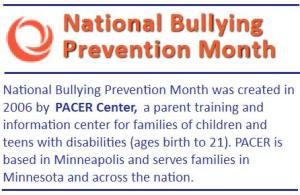“National Bullying Prevention Month” originally appeared at freespiritpublishingblog.com.
Copyright © 2020 by Free Spirit Publishing. All rights reserved.
This month, our nation is focusing more on bullying prevention. But the fact is, bullying happens every single day of the school year.
![]() The statistics tell us:
The statistics tell us:
- 1 in 3 students is the victim of bullying.
- 1 in 3 students bullies someone.
- Nearly 9 out of 10 students have been “bystanders,” or those who see or know about bullying.
Kids tell us:
- “Every day I get called weird, freaky, and stupid—and way worse than those.”
- “I hate going to school because people spread fake rumors about me. They don’t even know me!”
- “I cried like every day of fifth grade because of the bullies.”
 These days, we’re all hearing more about the issue of bullying because people young and old are speaking out. One thing we can do during October for National Bullying Prevention Month is to be sure the voices grow louder.
These days, we’re all hearing more about the issue of bullying because people young and old are speaking out. One thing we can do during October for National Bullying Prevention Month is to be sure the voices grow louder.
Talk to your children about bullying; ask them if they’ve been bullied or if they’ve bullied others. Be open and honest to create a feeling of trust. Let the kids in your life know you’re willing to listen and help.
In 2012, Phyllis Kaufman Goodstein and I were working on Bystander Power, a book for kids ages 8–13 on how to recognize, stand up to, and prevent bullying. While researching and writing, we discovered:
- Boys do more physical bullying than girls do.
- Boys and girls do an equal amount of verbal bullying.
- Both boys and girls take part in relational bullying (damaging a victim’s relationship with friends and peers), but girls do more of it.
- Both girls and boys cyberbully. One in 5 students is cyberbullied, and 1 in 5 students cyberbullies.
There’s good news, though:
When kids intervene and give help, bullying stops in 10 seconds or less more than half the time.
 So, kids can have a positive influence. They have a voice. They have the power to effect change, and that power is more than any bully has. It’s up to us, as adults, to help them raise their voices so change can happen—at school, in the neighborhood, on the bus, in chat rooms, on social media sites, and anywhere bullying takes place.
So, kids can have a positive influence. They have a voice. They have the power to effect change, and that power is more than any bully has. It’s up to us, as adults, to help them raise their voices so change can happen—at school, in the neighborhood, on the bus, in chat rooms, on social media sites, and anywhere bullying takes place.
“The culture of bullying won’t end until people across the country take action and show kids that they care,” says Julie Hertzog, director of PACER’s National Bullying Prevention Center.
The month of October is a great time to start . . . but bullying prevention is something we should all pay attention to year round. How have you worked to raise awareness of bullying in your family or school?
Elizabeth Weiss Verdick has written children’s books for kids of all ages, from toddlers to teens. Elizabeth loves helping kids through her work as a writer, an editor, and a mentor to children and teens. She lives in Minnesota where she plays traffic cop for her many furry, four-footed friends.
